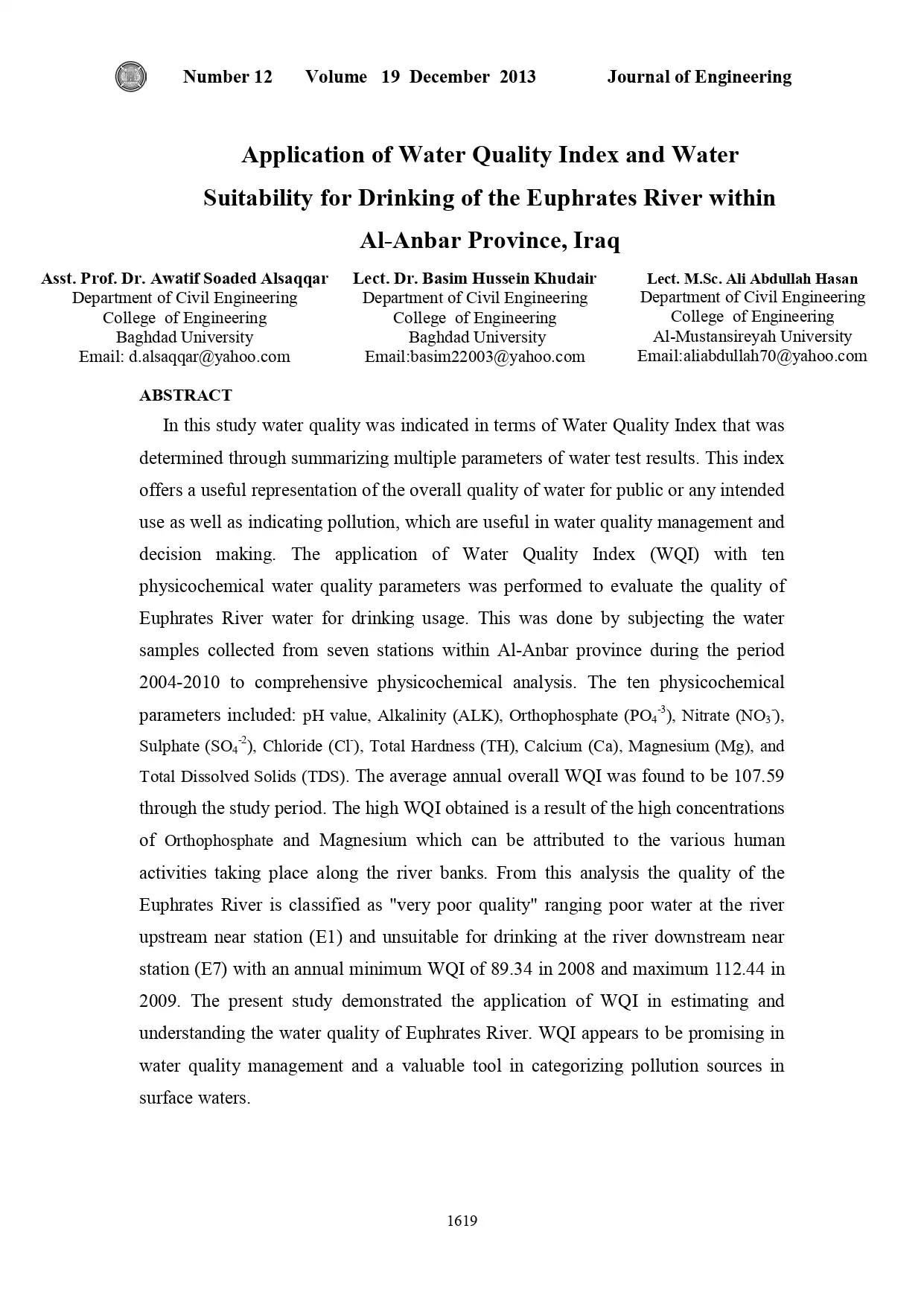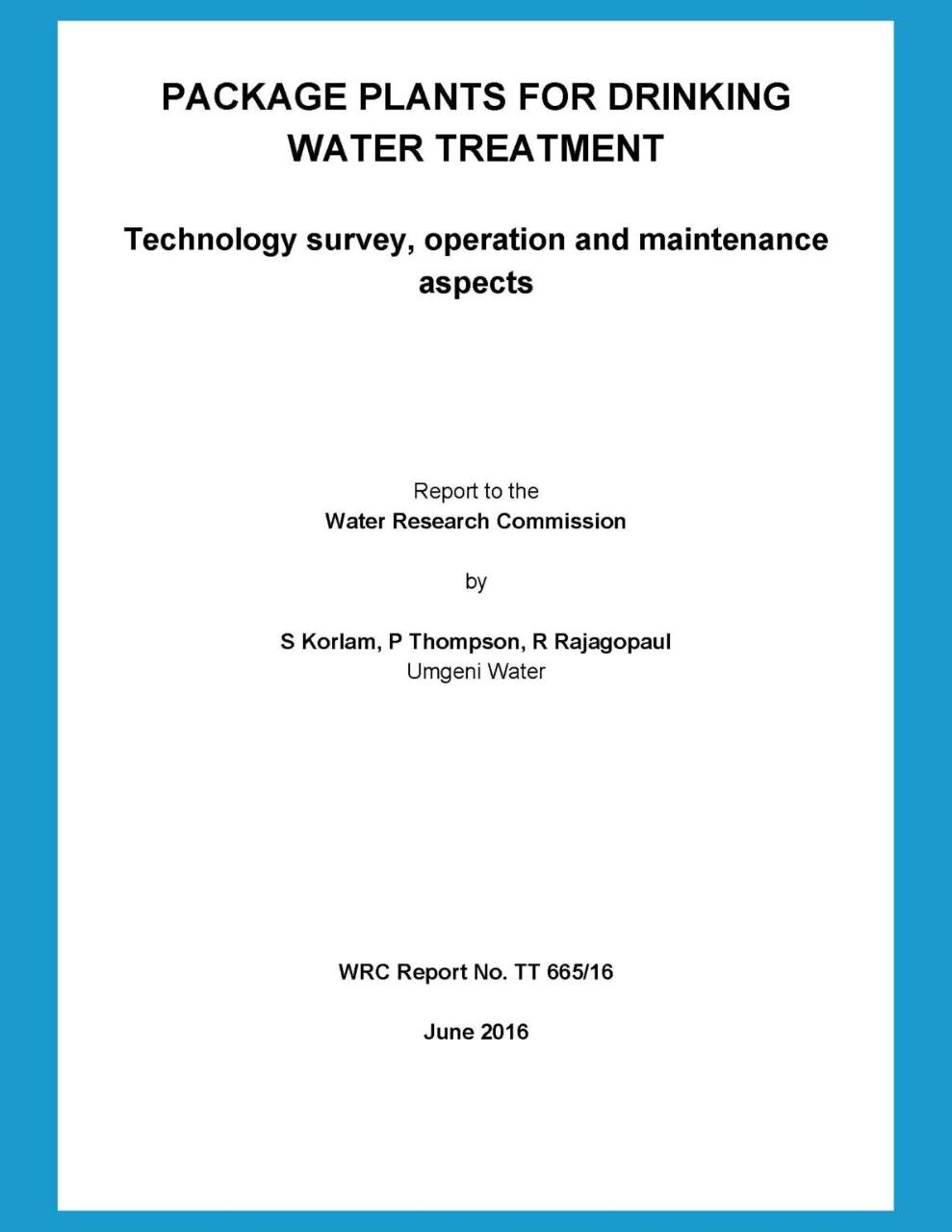Arsenic Removal From Drinking Water By Advanced Filtration Processes
All over the world the presence of arsenic in water sources for human consumption has been raising great concern in terms of public health since many epidemiologic studies confirm the potential carcinogenic effect of arsenic. Because arsenic removal is the most frequent option for safe drinking water, the development of more efficient and sustainable technologies is extremely important. Membrane separation processes are suitable for water treatment because they can provide an absolute barrier for bacteria and viruses, besides removing turbidity and colour. Their application is a promising technology in arsenic removal since it does not require the addition of chemical reagents nor the preliminary oxidation of arsenite required in conventional treatment options. However, since membrane technologies such as reverse osmosis can be a very expensive and unsustainable treatment option for small water supply
systems, it becomes crucial that alternative methods are developed. This work presents a few conclusions based on a laboratorial study performed to evaluate the efficiency of arsenic removal using ultrafiltration, microfiltration and solar oxidation processes under different experimental conditions for relevant parameters. The results showed removal efficiencies higher than 90%. Key-words: safe drinking water, arsenic removal, membranes, public health.
Arsenic Removal From Drinking Water By Advanced Filtration Processes
All over the world the presence of arsenic in water sources for human consumption has been raising great concern in terms of public health since many epidemiologic studies confirm the potential carcinogenic effect of arsenic. Because arsenic removal is the most frequent option for safe drinking water, the development of more efficient and sustainable technologies is extremely important. Membrane separation processes are suitable for water treatment because they can provide an absolute barrier for bacteria and viruses, besides removing turbidity and colour. Their application is a promising technology in arsenic removal since it does not require the addition of chemical reagents nor the preliminary oxidation of arsenite required in conventional treatment options. However, since membrane technologies such as reverse osmosis can be a very expensive and unsustainable treatment option for small water supply
systems, it becomes crucial that alternative methods are developed. This work presents a few conclusions based on a laboratorial study performed to evaluate the efficiency of arsenic removal using ultrafiltration, microfiltration and solar oxidation processes under different experimental conditions for relevant parameters. The results showed removal efficiencies higher than 90%. Key-words: safe drinking water, arsenic removal, membranes, public health.
Appropriate Technologies For Drinking Water Treatment In Mediterranean Countries
This paper aims at analyzing the drinking water issue in the Mediterranean region, highlighting the principal problems and the appropriate technologies applicable in the different countries. The countries of this area are characterized by a huge variety from social, cultural, economic and environmental point of view. In particular, water distribution is inhomogeneous between the North, East, and South; even the type of water sources and the related quantity and quality problems differ country by country. Potable water comes from brackish and seawater, surface water, groundwater and water reservoirs with each source face different issues. The main problem of brackish and seawater for example is the high salinity and the contamination by disinfection byproducts, in addition to the microbiological and chemical contamination due to human activities that characterize also other surface water sources. Groundwater is also affected by human activity and it is not exempted from salinity because of the water intrusion. Moreover, water reservoirs are often contaminated by seasonal algal blooms. Technologies applied for drinking water treatment vary country by country. The paper presents the main treatment processes
associated with the main water pollutants, according to the Mediterranean region. Case studies of drinking water treatment plants are also analyzed, presenting alternative technologies appropriate for specific contexts, among others. The characteristics of each specific context should be carefully analyzed in order to develop the most appropriate technologies; high-end technologies for drinking water treatment may not be applied equally to all countries or communities of the Mediterranean region.
Appropriate Technologies For Drinking Water Treatment In Mediterranean Countries
This paper aims at analyzing the drinking water issue in the Mediterranean region, highlighting the principal problems and the appropriate technologies applicable in the different countries. The countries of this area are characterized by a huge variety from social, cultural, economic and environmental point of view. In particular, water distribution is inhomogeneous between the North, East, and South; even the type of water sources and the related quantity and quality problems differ country by country. Potable water comes from brackish and seawater, surface water, groundwater and water reservoirs with each source face different issues. The main problem of brackish and seawater for example is the high salinity and the contamination by disinfection byproducts, in addition to the microbiological and chemical contamination due to human activities that characterize also other surface water sources. Groundwater is also affected by human activity and it is not exempted from salinity because of the water intrusion. Moreover, water reservoirs are often contaminated by seasonal algal blooms. Technologies applied for drinking water treatment vary country by country. The paper presents the main treatment processes
associated with the main water pollutants, according to the Mediterranean region. Case studies of drinking water treatment plants are also analyzed, presenting alternative technologies appropriate for specific contexts, among others. The characteristics of each specific context should be carefully analyzed in order to develop the most appropriate technologies; high-end technologies for drinking water treatment may not be applied equally to all countries or communities of the Mediterranean region.
Aerogel & Iron-Oxide Impregnated Granular Activated Carbon Media For Arsenic Removal
The goal of this project is to validate proof-of-concept testing for iron enriched granular activated carbon (GAC) composites (aerogel-GAC or iron-oxide impregnated) as a viable adsorbent for removing arsenic from groundwater and conduct technical and economic feasibility assessments for these innovative processes. Specific project objectives include: • Conduct batch experiments for aerogel-GAC and Fe-oxide impregnated GAC composites to evaluate their performance removing arsenic.
• Evaluate Fe-GAC media performance in rapid small scale column tests (RSSCTs) to assess arsenic removal in a more dynamic treatment system.
• Evaluate Fe-GAC potential for removal of other contaminants (e.g., methyl tertiary butyl ether, dissolved organic carbon).
• Characterize Fe-GAC media.
• Correlate performance and media characterization for possible selection of two media for a future second phase of this project.
Aerogel & Iron-Oxide Impregnated Granular Activated Carbon Media For Arsenic Removal
The goal of this project is to validate proof-of-concept testing for iron enriched granular activated carbon (GAC) composites (aerogel-GAC or iron-oxide impregnated) as a viable adsorbent for removing arsenic from groundwater and conduct technical and economic feasibility assessments for these innovative processes. Specific project objectives include: • Conduct batch experiments for aerogel-GAC and Fe-oxide impregnated GAC composites to evaluate their performance removing arsenic.
• Evaluate Fe-GAC media performance in rapid small scale column tests (RSSCTs) to assess arsenic removal in a more dynamic treatment system.
• Evaluate Fe-GAC potential for removal of other contaminants (e.g., methyl tertiary butyl ether, dissolved organic carbon).
• Characterize Fe-GAC media.
• Correlate performance and media characterization for possible selection of two media for a future second phase of this project.
Application of Water Quality Index and Water Suitability for Drinking of the Euphrates River within Al-Anbar Province, Iraq
In this study water quality was indicated in terms of Water Quality Index that was determined through summarizing multiple parameters of water test results. This index offers a useful representation of the overall quality of water for public or any intended use as well as indicating pollution, which are useful in water quality management and decision making. The application of Water Quality Index (WQI) with ten physicochemical water quality parameters was performed to evaluate the quality of Euphrates River water for drinking usage. This was done by subjecting the water samples collected from seven stations within Al-Anbar province during the period 2004-2010 to comprehensive physicochemical analysis.
Application of Water Quality Index and Water Suitability for Drinking of the Euphrates River within Al-Anbar Province, Iraq
In this study water quality was indicated in terms of Water Quality Index that was determined through summarizing multiple parameters of water test results. This index offers a useful representation of the overall quality of water for public or any intended use as well as indicating pollution, which are useful in water quality management and decision making. The application of Water Quality Index (WQI) with ten physicochemical water quality parameters was performed to evaluate the quality of Euphrates River water for drinking usage. This was done by subjecting the water samples collected from seven stations within Al-Anbar province during the period 2004-2010 to comprehensive physicochemical analysis.
Package Plants For Drinking Water Treatment
In efforts to make package plants more compact, affordable and easier to operate and maintain, it has been noted that the design and performance of some of these plants containing conventional treatment processes is sometimes compromised if technical expertise in this regard is lacking. Generally, there are several risks associated with poorly designed treatment systems, including loss of production, poor safety and compromised equipment and process unit efficiency with associated higher operating and maintenance costs. These risks have more severe consequences in the case of desalination (including water reclamation and water re-use) package plants. The objective of this project is to develop a set of guidelines to assist municipalities, water treatment practitioners, designers and package plant manufacturers in the specification and design of appropriate unit processes and operating parameters to fit the influent water quality, operating environment and other special treatment requirements.
Package Plants For Drinking Water Treatment
In efforts to make package plants more compact, affordable and easier to operate and maintain, it has been noted that the design and performance of some of these plants containing conventional treatment processes is sometimes compromised if technical expertise in this regard is lacking. Generally, there are several risks associated with poorly designed treatment systems, including loss of production, poor safety and compromised equipment and process unit efficiency with associated higher operating and maintenance costs. These risks have more severe consequences in the case of desalination (including water reclamation and water re-use) package plants. The objective of this project is to develop a set of guidelines to assist municipalities, water treatment practitioners, designers and package plant manufacturers in the specification and design of appropriate unit processes and operating parameters to fit the influent water quality, operating environment and other special treatment requirements.








